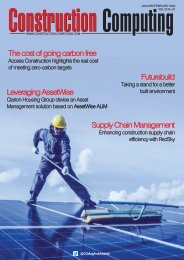You also want an ePaper? Increase the reach of your titles
YUMPU automatically turns print PDFs into web optimized ePapers that Google loves.
PRODUCT REVIEW REVIEW<br />
EXAGRID EX84<br />
Enterprises struggling with rapidly growing<br />
data centre storage capacities need to<br />
find new ways to energise their data<br />
protection strategies. If backup and restore<br />
performance can't keep up with these<br />
demands then their disaster recovery plans and<br />
service level agreements are unachievable.<br />
ExaGrid offers an ideal solution as its Tiered<br />
Backup Storage family of EX appliances<br />
delivers a smart backup and data recovery<br />
solution with a sharp focus on performance.<br />
The unique architecture allows it to scale out<br />
easily as storage capacities increase without<br />
impacting backup and recovery speeds.<br />
Tiered Backup Storage is superior to<br />
competing solutions which use a single<br />
intelligent controller head unit and dumb disk<br />
expansion shelves. Each EX appliance within a<br />
scale-out site is a complete system with its own<br />
storage, CPU, memory and networking so<br />
compute power and network bandwidth<br />
increase in step with capacity.<br />
Even more compelling is ExaGrid's data<br />
deduplication technology. It's well known that<br />
standard inline data reduction techniques hit<br />
backup and restore performance hard, but<br />
ExaGrid's patented Landing Zone feature with<br />
Adaptive Deduplication avoids all these<br />
problems.<br />
Data received from the backup application is<br />
written directly to a disk cache in<br />
undeduplicated format. As backups complete,<br />
the data in the Landing Zone is 'tiered' and<br />
written to a separate long-term retention<br />
repository where it is compressed and<br />
deduplicated. This process happens in parallel<br />
with the backups running but not inline in<br />
order to avoid a performance impact.<br />
This process has no impact on performance<br />
and as copies of the most recent backups are<br />
retained in the Landing Zone, most restore<br />
operations are much faster, as data doesn't<br />
need rehydration and decompression. Data<br />
security is also enhanced as while the Landing<br />
Zone is network facing, the repository has a<br />
tiered air gap between the network-facing<br />
Landing Zone and the non-network-facing<br />
retention repository and therefore is only visible<br />
to the ExaGrid software.<br />
This tiered air gap really comes into its own<br />
with ExaGrid's new Retention Time-Lock<br />
feature, which provides a solid defence<br />
mechanism against ransomware attacks. It's a<br />
simple yet elegant solution as it delays any<br />
delete requests to the offline repository that<br />
come into the Landing Zone via the user<br />
network or backup app.<br />
Delete requests will be carried out in the<br />
Landing Zone but once a time-lock period has<br />
been applied, they will have no impact on the<br />
retention repository. The period defaults to 10<br />
days but can be as long as 30 days and at the<br />
default setting ExaGrid states it will only result<br />
in a 10% increase in capacity requirements.<br />
This delayed delete setting is separate from the<br />
system's backup retention policy that can be<br />
any number of days, weeks, months and years.<br />
If a ransomware attack gains control of the<br />
backup software, the hacker could conceivably<br />
delete all backups with a single PowerShell<br />
command. Using delete request thresholds, the<br />
ExaGrid system issues warnings and if an<br />
attack is detected, administrators can respond<br />
immediately by suspending all further share<br />
access and taking them offline.<br />
Should an attack succeed in encrypting data,<br />
ExaGrid has immutable data objects that are<br />
not modified or overwritten so all previous<br />
retention does not change. It's a simple<br />
process to recover it as you browse the<br />
repository to find the latest unencrypted<br />
backup. Even the Retention Time-Lock setting<br />
is protected from tampering as any changes to<br />
this must be verified by a user assigned the<br />
ExaGrid Security Officer role.<br />
ExaGrid is highly flexible as a single scale-out<br />
system can comprise up to 32 appliances and<br />
you can mix any of the EX models together<br />
allowing you to tailor expansion to your<br />
budget and backup requirements. Existing<br />
customers needn't worry: all the older EX<br />
models from the previous range are supported<br />
so they can preserve their investment.<br />
The latest EX family comprises seven models<br />
with the flagship EX84 on review offering a<br />
truly staggering storage potential. This 4U<br />
rackmount appliance presents a usable<br />
backup capacity of up to 168TB and when<br />
28 <strong>ST</strong>ORAGE <strong>Mar</strong>/<strong>Apr</strong> <strong>2021</strong><br />
@<strong>ST</strong>MagAndAwards<br />
www.storagemagazine.co.uk<br />
MAGAZINE

















